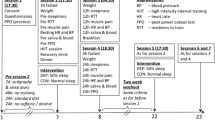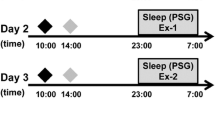Summary
The purpose of the study was to compare the cardiovascular, respiratory and metabolic responses to exercise of highly endurance trained subjects after 3 different nights i.e. a baseline night, a partial sleep deprivation of 3 h in the middle of the night and a 0.25-mg triazolam-induced sleep. Sleep-waking chronobiology and endurance performance capacity were taken into account in the choice of the subjects. Seven subjects exercised on a cycle ergometer for a 10-min warmup, then for 20 min at a steady exercise intensity (equal to the intensity corresponding to 75% of the predetermined maximal oxygen consumption) followed by an increased intensity until exhaustion. The night with 3 h sleep loss was accompanied by a greater number of periods of wakefulness (P<0.01) and fewer periods of stage 2 sleep (P<0.05) compared with the results recorded during the baseline night. Triazolam-induced sleep led to an increase in stage 2 sleep (P<0.05), a decrease in wakefulness (P<0.05) and in stage 3 sleep (P<0.05) After partial sleep deprivation, there were statistically significant increases in heart rate (P<0.05) and ventilation (P<0.05) at submaximal exercise compared with results obtained after the baseline night. Both variables were also significantly enhanced at maximal exercise, while the peak oxygen consumption (VO2) dropped (P<0.05) even though the maximal sustained exercise intensity was not different. Lactate accumulation was altered by sleep loss, undergoing an upward drift from the 9th min of steady power output [4.92 (SEM 0.44) mmol·1−1 vs control (CT) 3.91 (SEM 0.27) mmol·1−1, P<0.05] until maximal effort [10.92 (SEM 0.83) mmol·1−1 vs CT 9.26 (SEM 0.79) mmol·1−1, P<0.05]. After triazolam-induced sleep, heart rate, ventilation, (VO2) and blood lactates were not significantly different during steady power output from the values observed after the baseline night. However the maximal sustained exercise intensity was greater [380 (SEM 13.1) W vs CT 361.4 (SEM 13) W, P<0.01], which led to an increase in ventilation (P<0.01) without any change in heart rate, (VO2) or lactate concentration. These results suggested that partial sleep loss may have contributed to the change in athletic performance and that triazolam did not impair the physiological responses to exercise during the following afternoon.
Similar content being viewed by others
References
Balkin JT, O'Donnell VM, Kamimori GH, Redmond DP, Belenky G (1989) Administration of triazolam prior to recovery sleep: effects on sleep architecture, subsequent alertness and performance. Psychopharmacology 99:526–531
Bastuji H, Jouvet M (1985) Intérět de l'agenda de sommeil pour l'étude des troubles de la vigilance. Electroencephalogr Clin Neurophysiol 60:229–305
Bond V, Balkissoon B, Franks BD, Brunlow R, Caprarola M, Bartley D, Banks M (1986) Effects of sleep derivation on performance during submaximal and maximal exercise. J Sport Med 26:169–174
Bonnet MH (1989) The effect of sleep fragmentation on sleep and performance in younger and older subjects. Neurobiol Aging 10:21–25
Borbely AA (1982) A two process model of sleep regulation. Human Neurobiol 1:195–204
Carskadon MA, Dement WC (1989) Normal human sleep: an overview. In: Kryger MH, Roth T, Dement CD (eds) Principles and practice of sleep medicine. Sanders, Montreal, pp 3–13
Charles RB, Kirkham AJT, Guyatt AR, Parker SP (1987) Psychomotor, pulmonary and exercise responses to sleep medication. Br J Clin Pharmacol 24:191–197
Chen HI (1990) Effects of 30 h sleep loss on cardiorespiratory functions at rest and in exercise. FASEB J 4:A862
Christensen NJ, Galbo H, Hansen JF, Hesse B, Richter A, Trap-Jensen J (1979) Catecholamines and exercise. Diabetes 28:58–62
Francesconi RP, Stokes JW, Banderet LE, Kowel DM (1978) Sustained operations and sleep deprivation: effects on indices of stress. Aviat Space Environ Med 49:1271–1274
Hasan J, Urponen H, Vuori I, Partinen M (1988) Exercise habits and sleep in a middle-aged finnish population. Acta Physiol Scand 574:14–20
Heistad DD, Wheeler RC, Mark AL, Schmid PG, Abboud FM (1972) Effects of adrenergic stimulation on ventilation in man. J Clin Invest 51:1469–1475
Horne JA, Ostberg O (1976) A self assessment questionnaire to determine morningness-eveningness in human circadian rhythms. Int J Chronobiol 4:97–110
Horne JA, Staff LEH (1983) Exercise and sleep: body heating effects. Sleep 6:36–46
Horne JA, Pettitt AN (1984) Sleep deprivation and the physiological response to exercise under steady-state conditions in untrained subjects. Sleep 7:168–179
Johnson LC (1982) Sleep deprivation and performance. In: Webb WB (ed) Biological rhythms, sleep, and performance. Wiley, pp 111–141
Kales A, Kales JD, Bixler EO, Scharf MB, Russek E (1976) Hypnotic efficacy of triazolam: sleep laboratory evaluation of intermediate-term effectiveness. J Clin Pharmacol 16:399–406
Kindermann W, Schnabel A, Schmitt WM, Biro G, Cassens J, Weber F (1982) Catecholamines, growth hormone, cortisol, insulin and sex hormones in anaerobic and aerobic exercise. Eur J Appl Physiol 49:389–399
Klein KE, Brüner H, Ruff S, Wegmann HM (1969) Long duration flight — long working day fatigue in long distance flights. Paper presented at the Agardnato course on Advanced Operational Aviation Medicine, Institute of Aviation Medicine, GAF. Fürstenfeldbruck, available from Johnson LC (1982)
Lavoie JM, Helie R, Cousineau D (1984) Effects of rapid change in muscle glycogen availability on metabolic and hormonal responses during exercise. Eur J Appl Physiol 53:57–62
Martin BJ (1981) Effect of sleep deprivation on tolerance of prolonged exercise. Eur J Appl Physiol 47:345–354
Martin BJ (1986) Sleep deprivation and exercise. In: Pandolf KB (ed) Exercise and sport sciences reviews. MacMillan, New York
Martin BJ (1988) Sleep loss and subsequent exercise performance. Acta Physiol Scand 574:28–32
Martin BJ, Gaddis GM (1981) Exercise after sleep deprivation. Med Sci Sport Exerc 13:220–223
Martin BJ, Haney R (1982) Self-selected exercise intensity is unchanged by sleep loss. Eur J Appl Physiol 49:79–86
Martin BJ, Chen H (1984) Sleep loss and the sympathoadrenal response to exercise. Med Sci Sport Exerc 16:59–59
McMurray RG, Brown CF (1984) The effect of sleep loss on high intensity exercise and recovery. Aviat Space Environ Med 55:1031–1035
Meintjes AF, Driver HJ, Shapiro CM (1989) Improved physical fitness failed to alter the EEG patterns of sleep in young women. Eur J Appl Physiol 59:123–127
Mitler MM, Seidel WF, Van Den Hoed J, Greenblatt DJ, Dement WC (1984) Comparative hypnotic effects of flurazepam, triazolam, and placebo: a long-term simultaneous nighttime and daytime study. J Clin Psychopharmacol 4:2–13
Näveri H, Kuoppasalmi K, Harkonen H (1985) Plasma glucagon and catecholamines during exhaustive short term exercise. Eur J Appl Physiol 53:308–311
Ongini E, Barnett A (1985) Hypnotic specificity of benzodiazepines. Clin Neuropharmacol 8:S17-S25
Paxton SJ, Trinder J, Montgomery I (1983) Does aerobic fitness affect sleep? Psychophysiology 20:320–324
Penetar DM, Belenky G, Garrigan JJ, Redmond DP (1989) Triazolam impairs learning and fails to improve in a long range aerial deployement. Aviat Space Environ Med 60:594–598
Phillipson EA (1978) Respiratory adaptations in sleep. Annu Rev Physiol 40:133–156
Pickett GF, Morris AF (1975) Effects of acute sleep and food deprivation on total body response time and cardiovascular performance. J Sport Med 15:49–56
Plyley MJ, Shepard RJ, Davis GM, Goode RC (1987) Sleep deprivation and cardiorespiratory function. Eur J Appl Physiol 56:338–344
Rechtschaffen A, Kales A (1968) A manual of standardised terminology, techniques and scoring system for sleep stages of human subjects. Government Printing Office, Washington, D.C.
Shapiro CM, Warren PM, Trinder J, Paxton SJ, Oswald I, Flenley DC, Catterall JR (1984) Fitness facilitates sleep. Eur J Appl Physiol 53:1–4
Spinweber CL, Johnson LC (1982) Effects of triazolam (0.5 mg) on sleep, performance, memory and arousal threshold. Psychopharmacology 76:5–12
Sutton JR, Jones NL (1979) Control of pulmonary ventilation during exercise and mediators in the blood: CO2 and hydrogen ion. Med Sci Sport 11:198–203
Tilley AJ, Wilkinson RT (1984) The effects of a restricted sleep regime on the composition of sleep and on performance. Psychophysiology 21:406–412
Trinder J, Montgomery I, Paxton SJ (1988) The effects of exercise on sleep: the negative view. Acta Physiol Scand 574:14–20
Walsh JK, Muelbach MJ, Schweitzer PK (1984) Acute administration of triazolam for the daytime sleep of rotating shift workers. Sleep 7:223–229
Webb WB, Agnew HW (1965) Sleep: effects of a restricted regime. Science 150:1745–1747
Author information
Authors and Affiliations
Rights and permissions
About this article
Cite this article
Mougin, F., Simon-Rigaud, M.L., Davenne, D. et al. Effects of sleep disturbances on subsequent physical performance. Eur J Appl Physiol 63, 77–82 (1991). https://doi.org/10.1007/BF00235173
Accepted:
Issue Date:
DOI: https://doi.org/10.1007/BF00235173




